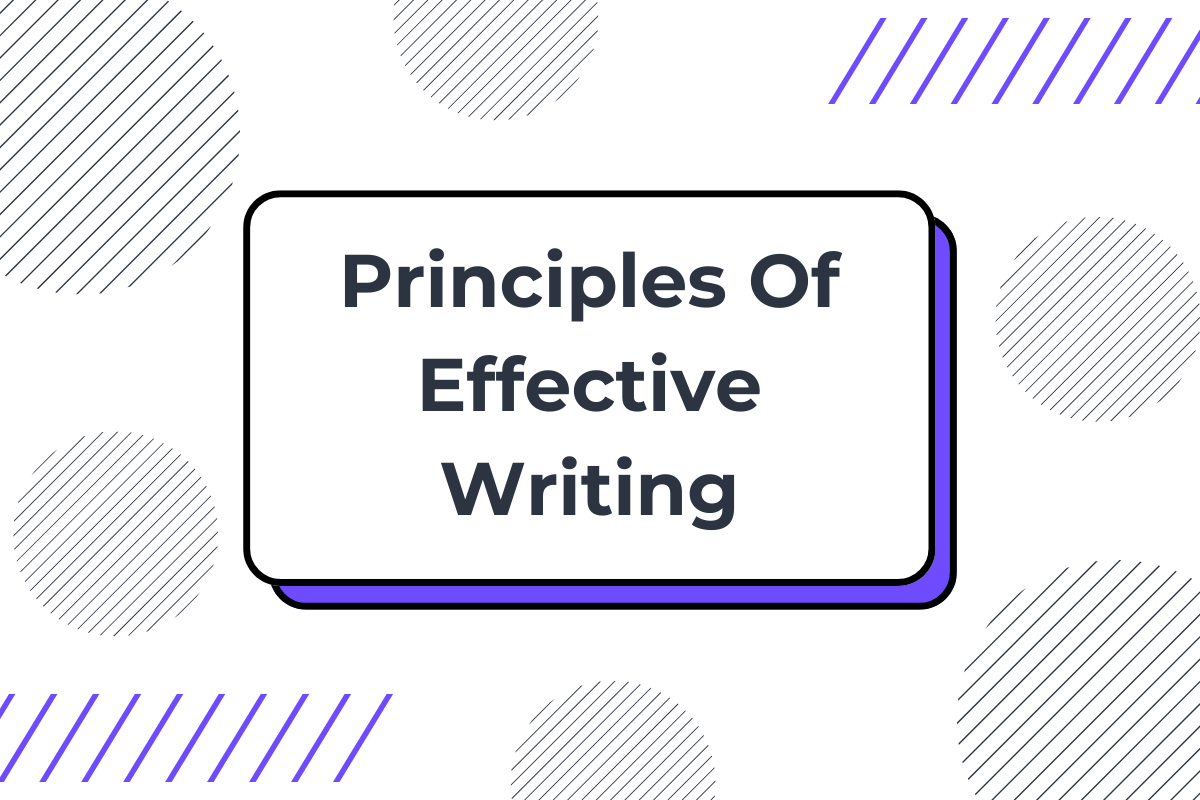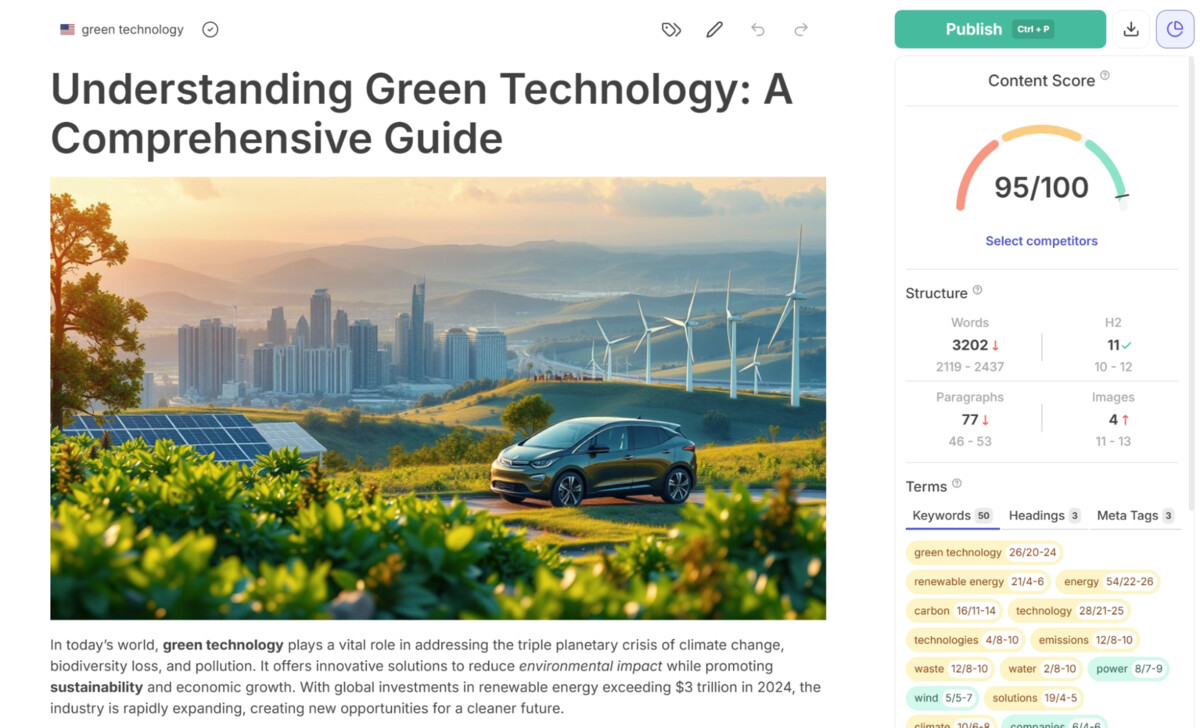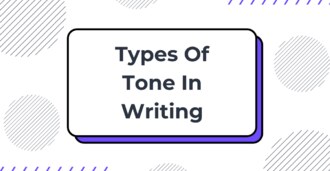15 Principles Of Effective Writing For Better Content

Bad writing creates confusion, wastes time, and loses readers. Whether you write emails, blog posts, or reports, mastering the effective writing principles will help you communicate better.
This guide presents the top 15 principles of effective writing that you can use right away. These principles work for any type of writing and will help you get your message across clearly and effectively. Let’s get started!
1. Clarity
Nothing matters more than clarity in writing. If readers can't understand your message, other qualities don't matter. To write clearly:
-
Use simple words instead of complex ones.
-
Explain one idea before moving to the next.
-
Define technical terms when needed.
Compare these examples:
Unclear: "The utilization of excessive terminology may result in comprehension difficulties." Clear: "Using too many big words makes your writing hard to understand."
When writing with clarity, it’s also important to ensure your writing is accurate and well-polished to give a smooth reading experience.
2. Grammar
Mistakes in grammar can make your writing confusing. They also lower the reader’s trust in what you're saying. Clear grammar helps you say what you mean, without miscommunication.
Good grammar isn’t about sounding formal. It’s about making sure every sentence follows a clear structure. When your sentences are correct, your message is easier to follow and harder to misread.
What to focus on:
-
Use subject-verb agreement. For example: “He writes well,” not “He write well.”
-
Keep tense consistent. Don’t jump between past and present without reason.
-
Use punctuation to break up ideas clearly.
-
Avoid run-on sentences. Break long thoughts into two short sentences if needed.
-
Double-check word use, like “your” vs “you’re,” or “its” vs “it’s.”
Always reread your writing once or twice, and consider using a grammar tool to catch what you miss. But don’t rely only on the tool. Read your work aloud—it helps you hear what sounds off.
3. Fluency
How your writing sounds when read affects how easy it is to understand. Your writing fluency and flow helps guide the reader through your ideas without tiring them.
Sentences that are all the same length or style feel robotic. Sentences that are too long can be tiring. However, a mix of short and medium-length sentences helps your writing move smoothly.
To improve your content’s fluency:
-
Read your writing out loud. If it feels heavy or awkward, adjust.
-
Use short sentences for key points.
-
Follow long sentences with shorter ones to balance the flow.
-
Break up long paragraphs to keep the pace steady.
Writing with proper fluency helps the reader move through your message and gives a better reading experience.
Related Read: Tips To Improve Content Readability Using AI
4. Active Voice
Active voice makes your writing clear and direct. It is one of the key principles of effective writing. It shows who is doing the action. In most cases, it’s better than passive voice, which hides the subject.
Examples:
-
Active: You submitted the form.
-
Passive: The form was submitted.
Active voice helps your writing sound more certain and less vague. It also makes sentences shorter and easier to read. Use passive voice only when the subject doesn’t matter or is unknown. Otherwise, in most cases, saying who did what using active voice is more useful.
5. Purpose
Every sentence should have a reason to be there. You need to know what you want to say and why you are saying it. Without a clear purpose, your writing can feel confusing or random.
Writing with purpose helps you stay on track. You avoid off-topic details, and you write in a way that leads your reader toward a clear point.
Before you write:
-
Decide your main goal.
-
Ask what action or thought you want to leave with the reader.
-
Remove anything that doesn’t support that goal.
When every part of your writing supports your purpose, your message becomes stronger.
6. Audience Awareness
Who will read your writing? This question should guide every writing decision you make. Understanding your audience helps you:
-
Choose the right level of detail.
-
Select relevant examples.
-
Use appropriate language and tone.
-
Handle their specific needs and questions.
For instance, writing for beginners requires more explanation than writing for experts. Writing for busy professionals needs to be more direct than writing for casual readers.
Take time to think about your readers' knowledge level, interests, and why they're reading your content. This helps you connect with them more effectively.
7. Conciseness
Good writing uses the fewest words needed to express an idea completely. To write concisely:
-
Cut unnecessary words and phrases.
-
Use one strong word instead of several weak ones.
-
Remove repetitive information.
Here’s an example:
Before: "At this point in time, it should be noted that the project team members are currently in the process of finalizing the initial draft of the proposal document."
After: "The team is finalizing the proposal draft."
The second version communicates the same information in 70% fewer words. Concise writing shows respect for your readers' time and attention.
Every extra word weakens your message. Short, focused writing respects your reader's time and makes it more effective.
Look at your current draft and ask: "What happens if I delete this sentence?" If nothing important is lost, cut it.
8. Simplicity
Simple writing is not the same as basic writing. It means saying things clearly without adding unnecessary steps, words, or structure.
Simplicity helps the reader absorb information faster. It removes friction from reading. When you write simply, your message becomes easier to understand and harder to forget.
Make your writing simple by:
-
Replacing complex words with common ones.
-
Using short, clear sentences.
-
Avoiding filler phrases like “needless to say,” “it should be noted that,” or “as such.”
-
Cutting any word or sentence that doesn’t add value.
If a reader can grasp your message in one read, you’re doing it right.
9. Emphasis
Not every part of your writing carries the same weight. Some points are more important than others. You need to show the reader what to focus on. That’s where emphasis helps.
You can’t rely on the reader to guess what’s important. You need to make it clear by how you write and where you place the key message.
How to create emphasis:
-
Put key ideas at the beginning or end of a paragraph.
-
Use short, direct sentences to highlight important points.
-
Use bold text for terms or phrases you want the reader to notice.
-
Use one idea per sentence, don’t put the main point under extra words.
Avoid overusing emphasis. If everything is bold or written with intensity, then nothing stands out. Use it with care, and only for what really matters.
10. Empathy
Understanding your readers' feelings and challenges helps you create content that connects deeply.
To write with greater empathy:
-
Research emotional pain points related to your topic.
-
Show you understand their frustrations before offering solutions.
-
Use language that shows you know what readers are feeling.
-
Share relevant stories that connect to reader challenges.
-
Ask yourself: "If I faced this problem, would this content help me?"
For instance, when you write about starting a blog, acknowledge the overwhelm new bloggers feel when facing technical setups, content planning, and promotion all at once.
Say "You might feel lost about where to start when every expert seems to give different advice" before you offer your step-by-step solution. This emotional connection makes your practical advice hit harder.
11. Concreteness
Vague advice creates forgettable content. Specific details create clear understanding.
To add helpful concreteness to your writing:
-
Replace general terms with exact descriptions.
-
Use precise numbers instead of "many" or "some."
-
Name specific tools, techniques, or resources.
-
Explain exactly how to implement advice step by step.
-
Add details that help readers visualize concepts.
For instance:
Don't write "create better headlines."
Instead, write "Use the 4U formula to create headlines that get more clicks: Make them Useful, Urgent, Unique, and Ultra-specific. For example, change 'Pinterest Tips' to 'Create 10 Stunning Pinterest Graphics in 15 Minutes (Even With Zero Design Skills).'"
Specific, and concrete advice makes your writing more effective and impactful.
12. Tone
Tone is how your writing sounds to the reader. It shows your attitude. You can be direct, helpful, firm, warm, or even neutral, all depending on your purpose and the reader.
When your tone doesn’t fit your message, it confuses the reader. For example, writing in a cold tone for a helpful guide might feel unwelcoming. Or using casual language in a formal report can sound careless.
To choose the right tone:
-
Think about how the reader might feel.
-
Match your words and sentence style to that feeling.
-
It is good to not sound too stiff or too chatty in writing unless the situation calls for it.
Quick examples:
-
Clear tone: “Use short sentences to stay focused.”
-
Too stiff: “One must employ concise syntax to maintain focus.”
-
Too casual: “Just go with short ones, yeah?”
Good tone keeps your writing respectful, clear, and easy to trust.
13. Formatting
No matter how well you write, if the layout is messy, readers won’t finish reading. Good formatting breaks your writing into smaller, readable parts. It helps readers find what they’re looking for faster.
Good formatting includes:
-
Short paragraphs with space between them.
-
Headings and subheadings to guide the reader.
-
Bullet points for quick lists.
-
Bold text for key terms.
-
Tables to show comparisons or summaries.
Avoid long blocks of text. Use line breaks often. Each section should feel easy to scan, even on a phone screen.
When your writing looks clean, readers stay longer. That’s not just better for them, it’s better for SEO too.
14. Completeness
A strong message answers the reader’s questions before they ask. That’s what completeness means. You give all the needed parts of the message, without making the reader search for more.
Incomplete writing makes people stop and wonder what they’re missing. It can lead to confusion or wrong conclusions.
To make your writing complete:
-
Check if every section has context, facts, and examples when needed.
-
Don’t assume the reader knows the background—briefly explain it.
-
Include what the reader should do next or think about after reading.
You don’t have to add fluff. Just cover the topic in full so that no part feels missing or rushed.
15. Editing
Your first version is not your final version. Strong writing comes from rewriting. That means reviewing what you wrote, cutting what doesn’t work, and making each part clearer.
Revision helps you remove weak words, fix unclear parts, and check the flow.
Steps for effective revision:
-
Read it out loud. If something sounds wrong, fix it.
-
Check for one idea per sentence.
-
Cut filler and tighten long sentences.
-
Look at each paragraph and ask: Does this help the reader?
-
Take a short break before editing so you can come back with a fresh view.
Don’t treat editing as a chore. It’s where your writing becomes better.
Want Help Writing Effective SEO Content? Try SEOWriting!

If you're writing content for a blog or website, applying all the effective writing principles can be time-consuming and challenging. That’s where SEOWriting can help. It builds SEO-ready blog posts that follow writing best practices right from the start.

With SEOWriting, you can:
-
Create full-length SEO-Optimized blog posts in just one click.
-
Keep your content readable with built-in grammar and tone tools.
-
Use formatting that follows good writing structure automatically.
-
Avoid keyword stuffing while keeping SEO effective.
-
Adjust tone, length, and layout with custom controls.
It also handles internal and external linking, SEO formatting, and even generates AI images that match the post. You don’t have to spend time fixing layout or flow. SEOWriting takes care of that so you can focus on your ideas.
Final Thoughts
Clear writing starts with clear thinking. You don’t need big, complex words to write well. You just need to say the right things in a way that’s easy to follow.
Focusing on effective writing principles such as clarity, purpose, reader needs, and simplicity will help you make your writing easier to read and understand.
If you're working on content that needs to rank on search engines while staying easy to read, SEOWriting is the right tool for you. It can save time and help you keep your writing clean. With features built to support better writing, and SEO formatting, it's built for creating clear writing that performs. Try it for free now!



Write 10X Faster With AI-Powered Content
Create SEO-optimized articles in 15 minutes instead of 5 hours. Join 50,000+ content creators who generate content that ranks on top positions on Google. Save up to 80% of your time while getting 2X better results.
Try for Free →
